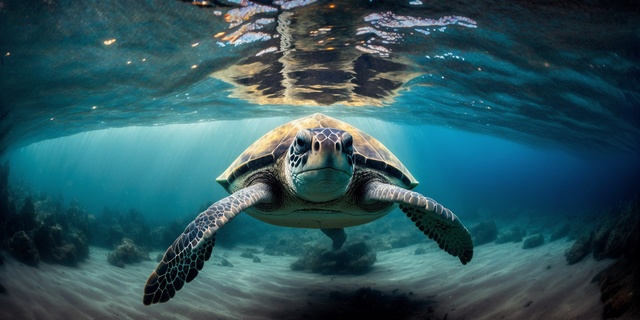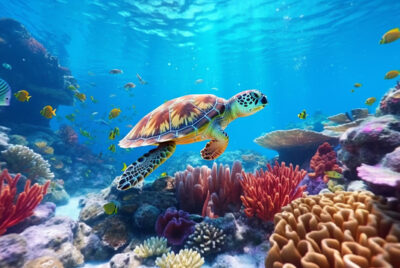Are Turtles Reptiles? Deep Dive Into Turtle Anatomy
Ah, the age-old debate! Are turtles’ reptiles? Let’s embark on a journey to unravel this mystery, and trust me, by the end, you’ll see these fantastic creatures in a new light!
What Defines a Reptile?
To many, the word ‘reptile’ conjures images of scaly dragons from folklore or those menacing velociraptors from the movies.
In reality, reptiles are a group of fascinating and diverse creatures that have graced our planet for millions of years. But what characteristics help scientists and enthusiasts alike classify an animal as a reptile? Let’s dive deeper.
Ectothermic Nature:
Reptiles are ectothermic, commonly referred to as ‘cold-blooded’. This doesn’t mean their blood runs cold, but rather that they rely on external sources of heat to regulate their body temperature. You might notice lizards basking on a rock or snakes sprawling in a sunlit patch. They’re absorbing the warmth they need to remain active. When it gets too hot, they’ll seek shade or burrow to cool down.
Scaly Protective Covering:
One of the most recognizable features of reptiles is their scaly skin. These scales are made of keratin, the same protein in our hair and nails. The scales serve a myriad of purposes: they provide protection against predators and environmental factors, reduce water loss through evaporation, and in some species, aid in camouflage.
Reproduction and Development:
Most reptiles lay eggs, but what’s noteworthy is the type of egg they produce. Reptilian eggs have a leathery or hard shell, often porous enough to allow for gas exchange but sturdy enough to protect the developing embryo. While many reptiles lay eggs on land, some species (like certain snakes) give birth to live young, a phenomenon known as viviparity.
Heart Structure:
Reptiles, with the exception of crocodilians, typically possess a three-chambered heart. This consists of two atria and a single, partially divided ventricle. This setup is quite different from the four-chambered hearts of mammals and birds and is more primitive in its structure and function.
Advanced Lungs:
While amphibians often rely on both skin and lungs for respiration, reptiles predominantly depend on their lungs. Over evolutionary time, reptilian lungs have become more complex and efficient, enabling better oxygen exchange, which is vital for activities like hunting or escaping predators.
Vision and Eyelids:
Ever tried staring down a lizard? You’d likely lose! Most reptiles have movable eyelids and excellent vision. Some species can even detect ultraviolet light, which is invisible to human eyes. This enhanced vision helps them in various tasks, from hunting prey to finding mates.
In essence, classifying an animal as a reptile goes beyond just the presence of scales or the ability to lay eggs. It’s a combination of various physiological, anatomical, and behavioral traits that have allowed these creatures to thrive in diverse habitats across the globe.
So, the next time you encounter a slithering snake or a basking turtle, you’ll have a deeper appreciation for the intricate world of reptiles.
Delving Into the Turtle’s World
As someone who’s spent considerable time studying and observing these animals, I find the question, “are turtles reptiles?” particularly intriguing. Let’s wade through the evidence and get a clearer picture.
Origins and Evolution:
Turtles belong to the order Testudines, and their history stretches back more than 200 million years, making them one of the oldest reptile groups, even older than snakes and crocodilians. This extensive evolutionary history offers a testament to their resilience and adaptability—traits characteristic of many reptiles.
Reptilian Characteristics of Turtles:
As we’ve learned about the defining traits of reptiles, let’s see how our shelled friends fit into the reptile checklist:
1) Ectothermic Behavior:
Turtles are classic ectotherms. Watch a turtle in its natural habitat, and you’ll often find it basking on logs or rocks, soaking up the sun’s rays to regulate its body temperature. This behavior is crucial for their digestion, mobility, and overall well-being.
2) Scales and a Unique Shell:
Turtles don’t just have scales; they have turned them into an art form! Their iconic turtle shell consists of a dorsal carapace and a ventral plastron, both of which are made up of modified scales. This protective armor is a key reptilian feature, albeit with a unique turtle twist.
3) Reproduction:
Like many reptiles, most turtles lay eggs. Their eggs have a flexible, leathery shell, allowing them to be laid on land without desiccation. Some aquatic turtles even have specialized adaptations for laying eggs in sand or mud.
4) Respiration:
Despite their aquatic tendencies, turtles primarily rely on lungs for breathing. Yes, some species can absorb limited oxygen through their skin or cloaca when submerged, but lungs remain their primary respiratory organ—a clear reptilian trait.
The Place of Turtles in the Reptile Family Tree:
Scientific classification further cements the turtle’s status as a reptile. Within the class Reptilia, turtles hold a distinct branch, separate from lizards, snakes, and crocodilians. Their unique evolutionary pathway, while setting them apart in many ways, still firmly places them within the overarching reptile group.
In essence, while turtles have some distinctive features and behaviors setting them apart from other reptiles, they undeniably fit within the reptilian criteria.
Their evolutionary history, biological characteristics, and physiological functions align seamlessly with what we understand as ‘reptilian’. So, the next time someone ponders the question, “are turtles reptiles?” you can confidently and passionately share your knowledge.
Turtles: Undeniably Reptilian
There’s something truly captivating about turtles and the different types. With their patient demeanor and unique armored bodies, they’ve held a special place in human fascination. But when it comes to the animal kingdom’s classifications, where exactly do these remarkable creatures fit in?
Let’s embark on a journey to explore why turtles, in every aspect, are undeniably reptilian.
Historical Recognition:
Historically, humans have always identified turtles as reptiles. Ancient civilizations, from the Greeks to the Chinese, associated turtles with mythological reptilian creatures, drawing parallels in their lore and art. This early recognition, though based on observation rather than scientific analysis, laid the foundational belief in the turtle’s reptilian nature.
Physical Characteristics and Behavior:
Several physical and behavioral traits of turtles mirror classic reptilian features:
1) Keratinous Scales and Shells:
The turtle’s body is covered in scales, much like many reptiles. But what makes them even more fascinating is the evolution of their iconic shell. This shell, made of fused bones and covered in keratinous scutes, is a living testament to their reptilian lineage.
2) Ectothermic Adaptations:
A quick stroll near a pond will often reveal turtles basking in the sun. This behavior isn’t just for leisure; as ectotherms, turtles depend on external heat sources to regulate their internal temperature. Their penchant for sunbathing is a distinct reptilian trait.
3) Sensory Perception:
Turtles, like many reptiles, possess a keen sensory system. They have excellent vision, even underwater, and can perceive a range of colors. This heightened sensory perception aids them in hunting, navigation, and avoiding threats—skills essential for reptilian survival.
Genetic and Evolutionary Evidence:
Modern science, with its tools of genetics and paleontology, provides further evidence of the turtle’s reptilian status. DNA analyses show that turtles share a significant portion of their genetic code with other reptiles. Fossil records depict ancient turtles that, while different in some aspects, still bear the undeniable hallmarks of reptilian ancestry.
The Broader Classification:
Taxonomically speaking, turtles belong to the class Reptilia. They form a unique order, Testudines, which distinguishes them from other reptiles. But their place within this class, alongside lizards, snakes, crocodilians, and birds (if considering the broader clade of reptiles), reaffirms their identity as reptiles.
The Role in Ecosystems:
Turtles, much like their reptilian cousins, play a crucial role in their ecosystems. They control insect populations, disperse seeds, and even shape the very landscapes of their habitats. Their ecological impact echoes the significance of reptiles in maintaining environmental balance.
Common Turtle Misconceptions
In our journey to understanding the world around us, misconceptions often arise, particularly when it comes to the diverse realm of wildlife. When we talk about turtles and their status as reptiles, numerous myths and misunderstandings come to the fore. Let’s take a moment to debunk some of these widespread fallacies.
1) Turtles are Amphibians:
Owing to their aquatic lifestyle and affinity for water, many folks mistakenly label turtles as amphibians. However, while both reptiles and amphibians might share watery habitats, their physiological and reproductive differences set them apart. Turtles, with their scaly skin and egg-laying habits, are definitively reptilian.
2) All Turtles Swim:
The image of a turtle might immediately conjure up visions of a creature gracefully navigating through water. Yet, not all turtles are swimmers. Tortoises, a subset of the turtle family, are terrestrial and prefer land over water.
3) Turtles Can Leave Their Shells:
Popular culture, especially in cartoons, often portrays turtles as creatures that can slip out of their shells. In reality, a turtle’s shell is part of its spine and ribcage, making it impossible for them to detach from it. It’s as integral to them as our backbone is to us.
4) Turtles are Slow on Land:
The age-old tale of the tortoise and the hare might have popularized the idea that all turtles are slow movers. While it’s true that many species are not built for speed, some, like the soft-shelled turtles, can be surprisingly quick when they need to be.
5) Turtles are Deaf and Dumb:
A common misconception is that turtles lack hearing or cognitive abilities. In reality, turtles have an intricate auditory system, allowing them to perceive vibrations and sounds. Their behavior and problem-solving abilities in the wild also suggest a level of intelligence that might surprise many.
6) All Turtles Have Hard Shells:
While the hard, protective shell is a defining characteristic of many turtle species, not all boast this feature. Some, like the leatherback sea turtle, have a more flexible and rubbery carapace, adapting them for deep-sea excursions.
7) Turtles are Immortal:
The impressive longevity of turtles, with some species living well past a century, has given rise to the myth of their immortality. While they are indeed among the animal kingdom’s long-livers, they are not immune to the passage of time or the vulnerabilities of life.
Dispelling these misconceptions allows us to truly appreciate turtles in all their complexity and splendor. By understanding them better, we can foster a deeper respect for these remarkable reptiles and their place in the world’s intricate web of life.
Why It Matters: The Importance of Classification
The world we inhabit is teeming with life, an intricate mosaic of organisms, each unique and each playing its role in the symphony of existence. Amidst this diversity, the need to categorize, classify, and understand becomes paramount. Why, you might ask? Let’s delve into why classification, especially in the world of biology, holds such significant importance.
1) Order Amidst Chaos:
Imagine a vast library with millions of books, but without any categorization – no genres, no alphabetical ordering, nothing. Finding a specific book in this chaos would be near impossible. Similarly, with millions of species on Earth, classification offers a systematic approach, making the study of organisms manageable and coherent.
2) Tracing Evolutionary Relationships:
Through classification, we can trace the evolutionary lineage of organisms. By understanding which species are closely related and which had a common ancestor, we glean insights into the history of life on Earth. Turtles, for instance, share a closer evolutionary relationship with birds and crocodiles than they do with lizards or snakes.
3) Facilitating Research:
When species are classified systematically, it becomes exponentially easier for researchers to identify and study them. Knowing the broader category to which an organism belongs can provide crucial information about its anatomy, physiology, and behavior without needing to study it from scratch.
4) Conservation Efforts:
Classification helps in identifying species that are endangered or at risk. By understanding their classification, conservationists can make informed decisions on how to protect these species, especially if they have specific habitats, dietary needs, or breeding patterns.
5) Medical and Scientific Applications:
Many species have medicinal properties or offer other benefits to humans. By classifying them, we can identify which organisms belong to a group that has historically provided medicinal compounds or other advantages. This is crucial for bioprospecting, where scientists search for the next potential medical breakthrough in nature.
6) Enhancing Communication:
Classification ensures that scientists across the globe have a consistent language. Whether in Tokyo or Toronto, a biologist knows what you’re referring to when you mention the order Testudines (turtles). This universality facilitates collaboration and the exchange of ideas.
7) Appreciating Biodiversity:
At a more profound level, classification helps us appreciate the sheer diversity of life. It makes us realize the myriad forms life has taken and the interconnectedness of it all. Every category, from the broadest phylum to the specific species, paints a picture of life’s grandeur and complexity.
In essence, the act of classification is not merely an academic or scientific endeavor. It’s a tool that helps us navigate the vastness of life on Earth, fostering a deeper understanding and appreciation. Just as understanding that turtles are reptiles gives us insights into their behavior, habitat, and evolutionary history, the broader practice of classification illuminates the tapestry of life in all its splendor.
Are Turtles Reptiles Conclusion
So, are turtles reptiles?
Unequivocally, yes!
These captivating creatures, with their ancient lineage and diverse habitats, are as reptilian as they come. Embrace this knowledge, and the next time someone sparks this debate, you’ll be armed and ready!
Are Turtles Reptiles FAQs
Why do some people think turtles are amphibians?
Likely because many species are aquatic. However, unlike amphibians, turtles don’t undergo metamorphosis.
Can turtles regulate their body temperature?
Yes, they’re ectothermic. They use their environment, like basking in the sun, to control their body temperature.
Do all turtles have hard shells?
Most do, but some species, like softshell turtles, have a more leathery carapace.
Are all turtles slow on land?
While they’re not sprinters, some species can move surprisingly quickly when motivated!
What’s the primary difference between turtles and tortoises?
Habitats and physical adaptations. Tortoises are land-dwellers with domed shells, while turtles can be aquatic with flatter shells and webbed feet.




